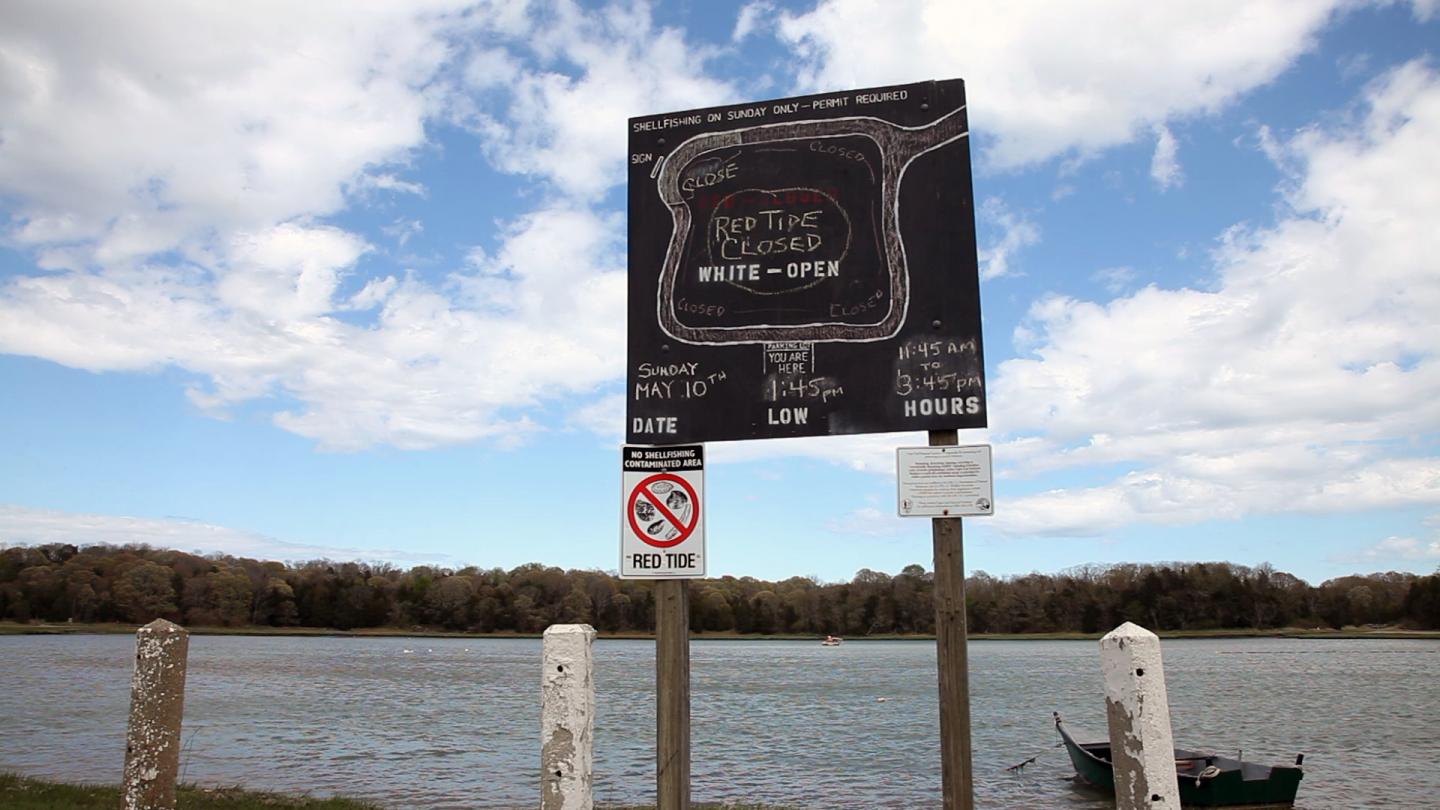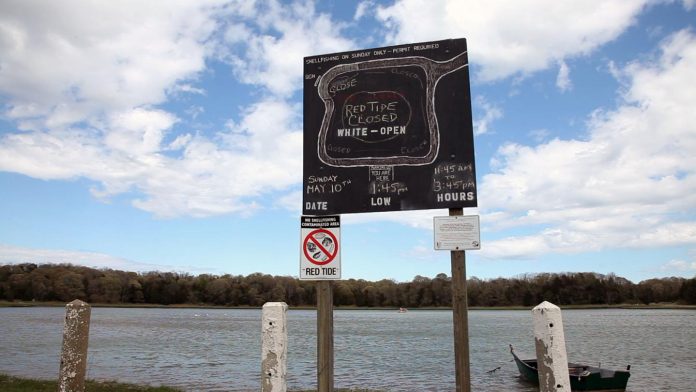
Photo: New funding from NOAA will help improve collective response in the U.S. to harmful algal blooms, including red tide, which are known to cause significant ecosystem, societal, and economic impacts…
view more
Credit Image: Photo by Daniel Cojanu, ©Woods Hole Oceanographic Institution
Researchers at Woods Hole Oceanographic Institution (WHOI) were recently named in a list of 17 new research projects funded by the National Oceanic and Atmospheric Administration (NOAA) to improve the nation’s collective response to the growing problem of harmful algal blooms (HABs). The four projects led, co-led, or supported by WHOI researchers total nearly $2.5 million over the coming year and $7.9 million over the course of the projects. A full list of the new grant awards is available online and includes projects funded under NOAA’s National Centers for Coastal Ocean Science (NCCOS) and the U.S. Integrated Ocean Observing System (IOOS?) Office.
“NOAA is funding the latest scientific research to support managers trying to cope with increasing and recurring toxic algae that continue to affect environmental and human health of coastal communities,” said David Kidwell, director of NOAA’s National Centers for Coastal Ocean Science (NCCOS) Competitive Research Program. “These projects will address the largely unknown socioeconomic impact of blooms in various regions, improve local managers’ ability to keep drinking water safe, aid monitoring for algal toxins in seafood and advance a potentially valuable control method for Florida red tide and other blooms, enhancing our nation’s collective response to these events.”
Marine and fresh waters teem with life, much of it microscopic, and most of it harmless. Although most of these phytoplankton and cyanobacteria are harmless, there are some that create potent toxins and, under the right conditions, both toxic and non-toxic species can form blooms that threaten the health of humans and ecosystems, and cause significant societal and economic problems.
These impacts include human illness and death following consumption of or indirect exposure to HAB toxins, economic losses to coastal communities and commercial fisheries, and HAB-associated wildlife deaths. Freshwater HABs can also affect drinking water supplies far from the ocean and are a growing problem as water temperatures rise, precipitation patterns change, and the use of agricultural fertilizers becomes more widespread.
“It’s impossible to ignore the growing natural, social, and economic impacts that HABs are having around the world,” said Don Anderson, WHOI senior scientist and Director of the U.S. National Office Harmful Algal Blooms. “NOAA’s support is critical to ensure that we have appropriate scientific understanding of these events and adequate monitoring and forecasting in place to protect our nation’s people, animals, and ecosystems.”
Harmful Algal Bloom Community Technology Accelerator
Institutions: Southern California Coastal Ocean Observing System/University of California San Diego/Scripps Institution of Oceanography, Axiom Data Science LLC, Woods Hole Oceanographic Institution, University of California Santa Cruz, Central and Northern California Ocean Observing System
Project Period: September 2020 – August 2023
Funding: $1,193,561 (FY2020: $399,998)
HABs are persistent threats to coastal resources, local economies, and human and animal health throughout U.S. waters and are expected to intensify and/or expand as oceans change in response to climate change. As a result, there is an immediate need for more effective strategies and technologies to monitor and communicate the risk of algal toxins to human and ecosystem health in U.S. waters. A WHOI-based team led by biologists Heidi Sosik and Stace Beaulieu will contribute to this effort by helping deploy off the coast of California six Imaging FlowCytobots (IFCBs)–automated camera systems that image, identify, and count plankton species in the water and report data to shore in real-time.
Value of the Pacific Northwest HAB Forecast
Institutions: Woods Hole Oceanographic Institution, University of Washington, Washington State Department of Fish and Wildlife, Oregon Department of Fish and Wildlife
Project Period: September 2020 – August 2023
Funding: $899,896 (FY2020: $299,948)
Razor clam and Dungeness crab fisheries along the Washington and Oregon coasts have been adversely affected by marine algae that produce the toxin domoic acid. The razor clam fishery is the largest recreational bivalve shellfish fishery in the region and a major source of tourist-related income to small communities along the coast. This project, led by Di Jin and Porter Hoagland of WHOI’s Marine Policy Center, will estimate the economic benefits of the Pacific Northwest HAB Bulletin, a forecasting tool that helps managers decide how and when to open and close the shellfisheries, by using a method for quantifying the value of information.
Assessing Societal Impacts of Harmful Macroalgae Blooms in the Caribbean
Institutions: University of Rhode Island and Woods Hole Oceanographic Institution
Project Period: September 2020 – August 2023
Funding: $838,137 (FY 2020: $318,292)
The number, distribution, and magnitude of blooms have increased in the Caribbean and Gulf of Mexico since 2011, with subsequent impacts on coastal ecosystems that have led many to consider them a new type of natural disaster in this region. This study co-led by Di Jin of the Marine Policy Center will examine how periodic blooms of free-floating Sargassum and subsequent mitigation efforts in the Caribbean affect social resilience across multiple dimensions, including economic impacts, human wellbeing, local ecological knowledge, and individual attitudes, values, and behaviors.
Trophic Transfer and Effect of HAB Toxins in Alaskan Marine Food Webs
Institutions: NOAA Northwest Fisheries Science Center, Woods Hole Oceanographic Institution, NOAA Alaska Fisheries Science Center, NOAA National Centers for Coastal Ocean Science, Florida Fish and Wildlife Research Institute, Alaska Veterinary Pathology Services, Sitka Tribe of Alaska, Alaska Sea Grant, University of Alaska Fairbanks, North Slope Borough, United States Geological Survey
Project Period: September 2020 – August 2025
Funding: $4,989,708 (FY2020: $1,460,870)
HABs and their toxins, particularly paralytic shellfish toxins produced by Alexandrium spp. and domoic acid produced by Pseudo-nitzschia spp., are increasingly present in Alaskan waters and have been detected in commercially valuable shellfish and finfish, and in animals that are not often studied by HAB researchers but which are targeted by subsistence hunters, including seabirds, seals, walruses, sea lions, and whales. The goal of this project, co-led by Don Anderson of the Biology Department is to model the movement and impacts of HAB toxins in Arctic and Subarctic food webs and reveal the extent of their impacts on human and natural ecosystems.
The Woods Hole Oceanographic Institution (WHOI) is a private, non-profit organization on Cape Cod, Massachusetts, dedicated to marine research, engineering, and higher education. Established in 1930, its primary mission is to understand the ocean and its interaction with the Earth as a whole, and to communicate an understanding of the ocean’s role in the changing global environment. WHOI’s pioneering discoveries stem from an ideal combination of science and engineering–one that has made it one of the most trusted and technically advanced leaders in basic and applied ocean research and exploration anywhere. WHOI is known for its multidisciplinary approach, superior ship operations, and unparalleled deep-sea robotics capabilities. We play a leading role in ocean observation, and operate the most extensive suite of data-gathering platforms in the world. Top scientists, engineers, and students collaborate on more than 800 concurrent projects worldwide–both above and below the waves–pushing the boundaries of knowledge and possibility. For more information, please visit http://www.
###















